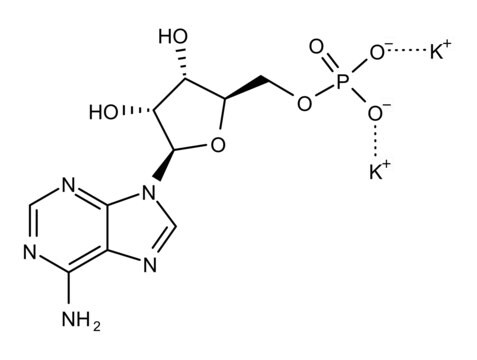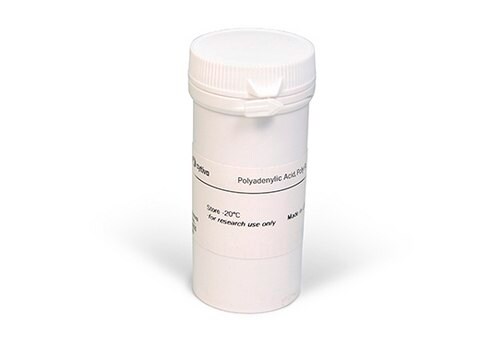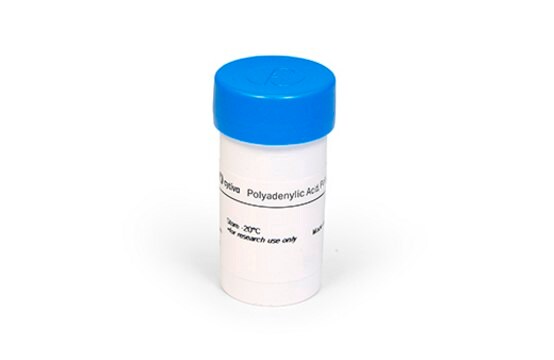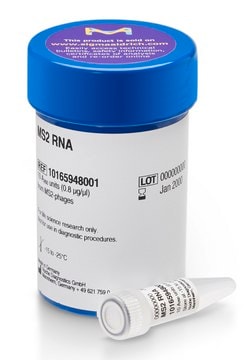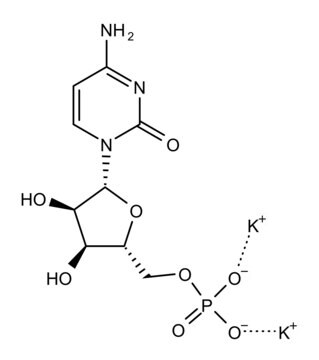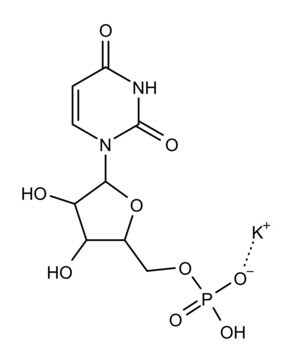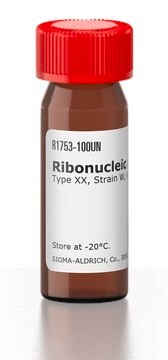10108626001
Roche
Poly(A)
lyophilized, suitable for PCR, pkg of 100 mg
Synonym(s):
Poly(A), Polyadenylic acid
Sign Into View Organizational & Contract Pricing
All Photos(1)
About This Item
UNSPSC Code:
41105600
Recommended Products
description
Polyadenylic acid
Quality Level
form
lyophilized
mol wt
700-3500 kDa
packaging
pkg of 100 mg
manufacturer/tradename
Roche
concentration
0.5 mg/mL (Working concentration)
technique(s)
PCR: suitable
color
white
solubility
water: soluble
absorbance ratio
A290/260 nm 0.03-0.05
A280/260 nm 0.28-0.32
A250/260 nm 0.86-0.90
storage temp.
2-8°C
General description
Poly(A) is used as a carrier for quantitative precipitation of DNA and RNA.
Application
Poly(A) has been used for droplet digital PCR (ddPCR) assay.
Polyadenylic acid (Poly(A)) to inhibit Exo1′s exonuclease activity. It has also been used as a carrier to resuspend lyophilized gBlocks.
Biochem/physiol Actions
Polyadenylic acid (Poly(A)) tails present at 3′ end are produced in the cell nucleus. It contains ~250 nucleotides in mammalian cells. Poly(A) regulates mRNA decay and the initiation of translation. Cytoplasmic poly(A) extension modulates translation.
Quality
Typical analysis:
2.3μmol/mg Poly(A) (from absorbance) in relation to one mononucleotide unit. Chromatographically homogeneous.
Absorbance determination A250/A260, A280/A260, A290/A260
2.3μmol/mg Poly(A) (from absorbance) in relation to one mononucleotide unit. Chromatographically homogeneous.
Absorbance determination A250/A260, A280/A260, A290/A260
Sequence
Chain Length 2.100 to 10.000 nucleotides
Unit Definition
1 A260 unit corresponds to 40 μg ssRNA.
Physical form
Lyophilizate, potassium salt
Preparation Note
Working concentration: 0.5 mg/ml
A concentration of 0.5 mg/ml is recommended.
Working solution: 0.5 mg/ml is recommended.
A concentration of 0.5 mg/ml is recommended.
Working solution: 0.5 mg/ml is recommended.
Other Notes
For life science research only. Not for use in diagnostic procedures.
Storage Class Code
11 - Combustible Solids
WGK
WGK 1
Flash Point(F)
Not applicable
Flash Point(C)
Not applicable
Certificates of Analysis (COA)
Search for Certificates of Analysis (COA) by entering the products Lot/Batch Number. Lot and Batch Numbers can be found on a product’s label following the words ‘Lot’ or ‘Batch’.
Already Own This Product?
Find documentation for the products that you have recently purchased in the Document Library.
Poly (A) tail length is controlled by the nuclear poly (A)-binding protein regulating the interaction between poly (A) polymerase and the cleavage and polyadenylation specificity factor
Kuhn U, et al.
The Journal of Biological Chemistry, 284(34), 22803-22814 (2009)
Yuichiro Miyaoka et al.
Scientific reports, 6, 23549-23549 (2016-04-01)
Precise genome-editing relies on the repair of sequence-specific nuclease-induced DNA nicking or double-strand breaks (DSBs) by homology-directed repair (HDR). However, nonhomologous end-joining (NHEJ), an error-prone repair, acts concurrently, reducing the rate of high-fidelity edits. The identification of genome-editing conditions that
Poly (ADP-ribose)-binding promotes Exo1 damage recruitment and suppresses its nuclease activities
Cheruiyot A, et al.
DNA Repair, 35, 106-115 (2015)
Peiguo Yang et al.
Cell, 181(2), 325-345 (2020-04-18)
The mechanisms underlying ribonucleoprotein (RNP) granule assembly, including the basis for establishing and maintaining RNP granules with distinct composition, are unknown. One prominent type of RNP granule is the stress granule (SG), a dynamic and reversible cytoplasmic assembly formed in
Our team of scientists has experience in all areas of research including Life Science, Material Science, Chemical Synthesis, Chromatography, Analytical and many others.
Contact Technical Service